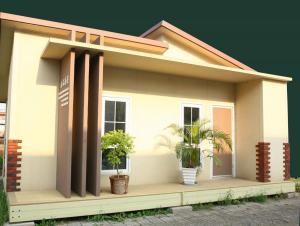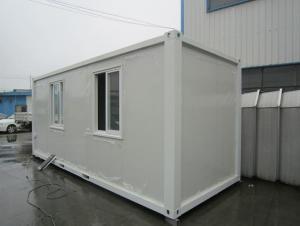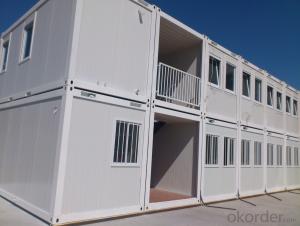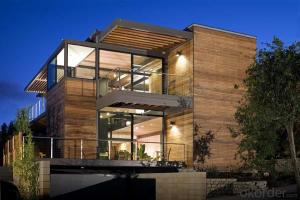Container House Low Cost from CNBM with CE Certificated
- Loading Port:
- Tianjin
- Payment Terms:
- TT OR LC
- Min Order Qty:
- 3 set
- Supply Capability:
- 500 set/month
OKorder Service Pledge
OKorder Financial Service
You Might Also Like
Low Cost Container House Low Cost from CNBM with CE Certificated
1. The benefits of Container House
Perfect for modular/prefab site offices,cabins,warehouse,villa,toliet,shop,hotel,camp,office
Efficient, low cost designs that can be customized for end user requirements
Easy for low skilled workers to assemble
The light steel frame structure is strong and reliable
Many modular homes can be stacked and linked together to create more space
Neat inside: plumbing and wires are hidden into the sandwich panel
2. Certificates:
ISO9001, ISO14001, CSA(Canadian Standards Association), CE(European Conformity), AU(Australia Standard),UL(America standard)
FAQ:
1.How about the installation? For example, the time and cost?
To install 200sqm house needs only 45 days by 6 professional workers. The salary of enginner is USD150/day, and for workers, it's 100/day.
2.How long is the life span of the house?
Around 50 years
3. And what about the loading quantity?
One 40'container can load 140sqm of house.
The cabin can be dis-assemebled for transport.
Images:
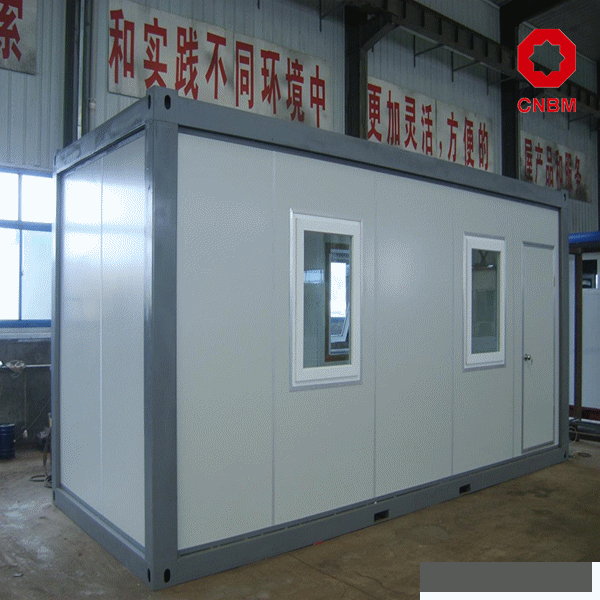


- Q:How do container houses handle extreme weather conditions?
- Container houses are built to be structurally robust and can withstand extreme weather conditions. These houses are typically made from durable steel shipping containers that are designed to be transported across the ocean. The steel construction of these containers provides a strong and sturdy framework that can withstand high winds and heavy storms. To further enhance their ability to handle extreme weather, container houses often undergo modifications. These modifications may include reinforcing the walls, floors, and roof with additional steel beams or adding insulation to improve thermal resistance. Reinforced windows and doors are also installed to provide better protection against strong winds and heavy rain. Additionally, container houses can be designed to be elevated or anchored to the ground, depending on the location and potential weather threats. Elevating the house can protect it from flooding, while anchoring it securely to the ground ensures stability during high winds. Moreover, container houses can be equipped with weather-resistant features such as hurricane shutters or impact-resistant glass to protect against extreme weather conditions like hurricanes or hailstorms. These features help to minimize damage and keep the inhabitants safe during such events. It is crucial to note that proper planning and design, along with regular maintenance, are essential for container houses to effectively handle extreme weather conditions. Regular inspections and repairs can ensure that any wear and tear are promptly addressed, maintaining the structural integrity of the house. Overall, container houses are designed to be resilient and can handle extreme weather conditions with the right modifications and maintenance.
- Q:How are container houses insulated?
- To ensure optimal energy efficiency and comfort, container houses employ various insulation methods. The insulation materials commonly utilized include spray foam, fiberglass, and rigid foam panels. These materials are applied to the container's interior walls, ceiling, and floor to establish a thermal barrier. Spray foam insulation is a favored choice due to its ability to expand and fill any gaps or crevices, creating an airtight seal that hinders heat transfer. This insulation is sprayed onto the container walls and solidifies into a cohesive layer. Another frequently employed option is fiberglass insulation. It consists of delicate glass fibers positioned between the container walls and shielded by a vapor barrier, preventing moisture accumulation. This type of insulation offers cost-effectiveness and commendable thermal performance. Rigid foam panels, composed of polystyrene or polyurethane, are also implemented in container house insulation. These lightweight and durable panels are affixed to the container walls, providing superb insulation properties. Reflective insulation may also be incorporated in container houses. This involves the installation of reflective foil or radiant barriers on the interior walls or roof of the container. These barriers deflect heat away from the house, maintaining cooler temperatures in hot climates. The insulation process plays a pivotal role in regulating indoor temperature, reducing energy consumption, and establishing a comfortable living environment in container houses. By combining various insulation materials and techniques, container houses can achieve remarkable insulation efficiency, making them a sustainable and cost-effective housing solution.
- Q:Can container houses be designed with a pet-friendly space?
- Yes, container houses can definitely be designed with a pet-friendly space. One of the advantages of container houses is their flexibility and adaptability in terms of design. With proper planning and consideration, it is absolutely possible to create a pet-friendly environment within a container house. To make a container house pet-friendly, several factors should be taken into account. Firstly, the layout and interior design of the house should be tailored to accommodate the needs of pets. This may include incorporating designated areas for pets such as a sleeping or resting space, play area, and feeding station. It's also important to consider the size and breed of the pet to ensure sufficient space and comfort. Additionally, the materials and finishes used in the construction of the container house should be pet-friendly. For example, using durable and easy-to-clean flooring options such as laminate or vinyl can be ideal for pets, as accidents or messes can be easily wiped away. Similarly, choosing furniture and upholstery that is resistant to scratches or stains can help maintain a pet-friendly environment. Furthermore, proper ventilation and natural lighting should be prioritized to ensure a healthy and comfortable living space for both the pet and the owner. Incorporating windows or skylights can provide ample natural light and fresh air, which are essential for pets' well-being. Lastly, outdoor spaces such as a balcony, deck, or even a small garden can be incorporated into the design to allow pets to enjoy the outdoors safely. Installing a secure fence or barrier around these spaces will ensure that pets are protected and cannot escape. In summary, container houses can be designed with a pet-friendly space by considering the layout, materials, ventilation, and outdoor areas. By taking these factors into account, it is possible to create a comfortable and safe living environment for both humans and their furry companions.
- Q:Can container houses be financed like traditional houses?
- Indeed, container houses can be financed in a similar manner to conventional houses. Numerous banks and financial institutions provide loans and mortgage alternatives designed specifically for container houses. These loans operate similarly to typical home loans, necessitating regular monthly payments over a predetermined duration. Nevertheless, it is important to recognize that the financing possibilities for container houses may differ depending on the lender and individual circumstances. Certain banks may impose more stringent lending criteria or impose distinct terms and conditions for container houses in contrast to traditional houses. It is recommended to seek advice from lenders who specialize in alternative housing choices to assess the most fitting financing options for container houses.
- Q:What are the common sizes of container houses?
- The common sizes of container houses vary, but they typically range from 20 to 40 feet in length.
- Q:Can container houses be designed with a modern aesthetic?
- Absolutely! Container houses can be designed to have a modern and sleek look. By utilizing the right architectural design and interior styling, container houses can be transformed into contemporary homes that are both functional and visually appealing. Achieving a modern aesthetic can be done by incorporating clean lines and minimalist design principles. Architects can optimize the shape and layout of the containers to create a streamlined and sophisticated appearance. Additionally, incorporating large windows and glass facades can bring in natural light and create an open and airy atmosphere, enhancing the modern appeal of the house. Customizing the exterior of the container house is another way to achieve a modern aesthetic. Applying a fresh coat of paint in contemporary colors, such as neutral tones or bold monochromatic schemes, can instantly update the containers' appearance. Furthermore, adding architectural elements like cantilevered balconies or green roofs can contribute to a modern and eco-friendly design. On the inside, container houses can be designed with modern finishes and fixtures. Using high-quality materials like stainless steel, glass, and concrete can create a sleek and polished look. Optimizing the layout to maximize open spaces and flow, while incorporating smart storage solutions, can maintain a clutter-free environment. Adding modern furniture and decor, such as minimalist pieces or statement lighting fixtures, can complete the contemporary aesthetic. In conclusion, container houses have the potential to be designed with a modern aesthetic. Through careful architectural planning, thoughtful interior design, and the use of contemporary finishes and materials, container houses can be transformed into stylish and modern homes that cater to the needs and preferences of today's homeowners.
- Q:Are container houses resistant to snow or heavy snowfall?
- Yes, container houses are generally resistant to snow or heavy snowfall. The structural integrity of container houses, combined with their durable materials, allows them to withstand the weight and pressure of snow. Additionally, the compact design of container houses helps to minimize the accumulation of snow on the roof, reducing the risk of any structural damage.
- Q:What are the building regulations for container houses?
- The building regulations for container houses vary depending on the country, state, and local jurisdiction. However, there are some general guidelines and considerations that are typically applicable when constructing a container house. Firstly, it is important to check with the local planning department or building control authority to determine if container houses are permitted in the area. Some regions may have restrictions or zoning regulations that limit or prohibit the use of shipping containers for residential purposes. In terms of structural requirements, container houses must meet certain standards to ensure their stability and durability. This may include reinforcing the container structure, adding additional support columns, or welding components together to create a more stable structure. The specific regulations for structural modifications will depend on the local building codes and engineering requirements. Insulation and ventilation are also crucial factors. Containers are made of steel, which can create challenges in terms of temperature control. Adequate insulation and ventilation systems must be installed to ensure the comfort and safety of the occupants. This may involve adding insulation materials to the walls, floors, and ceilings, as well as installing ventilation fans or windows for airflow. Electrical and plumbing systems must also comply with local building codes and safety regulations. This includes properly installing electrical wiring, outlets, and switches, as well as plumbing fixtures and connections. It is advisable to hire licensed professionals for these installations to ensure compliance with the regulations and to guarantee the safety of the occupants. Additionally, container houses may need to meet requirements related to fire safety, accessibility, and energy efficiency. This can include installing fire-resistant materials, providing accessible entrances and exits, and incorporating energy-efficient features such as solar panels or energy-saving appliances. Overall, it is crucial to research and consult with local authorities and professionals to understand the specific building regulations for container houses in your area. By following these regulations, you can ensure that your container house is safe, compliant, and suitable for long-term habitation.
- Q:Can container houses be designed with a built-in security system?
- Yes, container houses can definitely be designed with a built-in security system. The modular and customizable nature of container houses allows for the incorporation of various security features such as cameras, motion sensors, alarms, and smart locks. These security systems can be seamlessly integrated into the design and structure of container houses, providing homeowners with enhanced safety and peace of mind.
- Q:Are container houses suitable for small business offices?
- Indeed, container houses prove to be a viable choice for small business offices. They present various advantages that render them suitable for such purposes. To start with, container houses offer a cost-effective solution. Compared to conventional office spaces, their construction and maintenance costs are significantly lower. This proves particularly advantageous for small businesses operating on limited budgets, enabling them to save substantial amounts of money on rent and construction expenses. Moreover, container houses boast high levels of customization. They can be easily modified and tailored to meet the specific needs and requirements of small business offices. Containers can be stacked or interconnected to create larger office spaces, complete with all the necessary amenities, including electricity, plumbing, heating, and air conditioning. Additionally, container houses exhibit portability and flexibility. They can be effortlessly transported to different locations, making them an ideal choice for small businesses that frequently change their office space or operate in multiple areas. This mobility also allows for future expansion or downsizing, depending on the evolving needs of the business. Furthermore, container houses contribute to environmental preservation. By repurposing shipping containers, we can reduce waste and promote sustainability. This serves as a crucial consideration for small businesses aiming to adopt environmentally friendly practices and minimize their carbon footprint. Nevertheless, it is important to acknowledge certain limitations of container houses. The limited space available within a container may not be suitable for businesses requiring extensive office areas or accommodating a significant number of employees. Additionally, container houses may not align with the needs of businesses seeking a more professional or upscale image. In conclusion, container houses offer a suitable alternative for small business offices, providing cost-effectiveness, customization, portability, and eco-friendliness. Nevertheless, it is imperative to thoroughly evaluate the specific needs and requirements of the business before opting for container houses as office spaces.
1. Manufacturer Overview |
|
|---|---|
| Location | |
| Year Established | |
| Annual Output Value | |
| Main Markets | |
| Company Certifications | |
2. Manufacturer Certificates |
|
|---|---|
| a) Certification Name | |
| Range | |
| Reference | |
| Validity Period | |
3. Manufacturer Capability |
|
|---|---|
| a)Trade Capacity | |
| Nearest Port | |
| Export Percentage | |
| No.of Employees in Trade Department | |
| Language Spoken: | |
| b)Factory Information | |
| Factory Size: | |
| No. of Production Lines | |
| Contract Manufacturing | |
| Product Price Range | |
Send your message to us
Container House Low Cost from CNBM with CE Certificated
- Loading Port:
- Tianjin
- Payment Terms:
- TT OR LC
- Min Order Qty:
- 3 set
- Supply Capability:
- 500 set/month
OKorder Service Pledge
OKorder Financial Service
Similar products
New products
Hot products
Related keywords


















